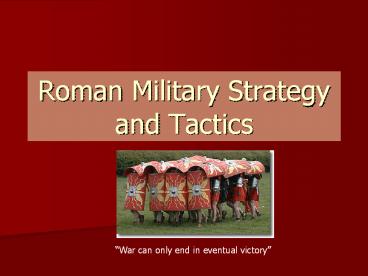Roman Military Strategy and Tactics - PowerPoint PPT Presentation
1 / 27
Title:
Roman Military Strategy and Tactics
Description:
Roman Military Strategy and Tactics War can only end in eventual victory Terms Hastati- younger soldier, early form of the legionnaire Velites- light infantry ... – PowerPoint PPT presentation
Number of Views:770
Avg rating:3.0/5.0
Title: Roman Military Strategy and Tactics
1
Roman Military Strategy and Tactics
War can only end in eventual victory
2
Terms
- Hastati- younger soldier, early form of the
legionnaire - Velites- light infantry, missile thrower
- Triarii- Veteran soldier, wealthier and more
heavily armed - Ferentarii- young, poor soldier
- Trireme- a ship with rectangular or triangular
sails wide enough for three rowers at each oar,
often equipped with a ram and siege weapons - Quinquereme- similar to a trireme, but five
rowers could be stationed at each oar, making the
ship much larger - Phalanx- rectangular military formation
consisting almost entirely of heavily armored
spearmen (though after Alexander the amount of
armor became less important in labeling a
division a phalanx)
- Scutum- large rectangular shield carried by Roman
legionnaires - Legionnaire- a member of an army (legion),
usually used to describe the standard heavy
infantry of the Imperial Roman Army - Pilum- heavy spear, could be thrown as a javelin
with an effective range of 20 meters - Contubernium- squad of eight men
- Maniple- subdivision of a legion consisting of
either 60 or 120 men. - Cohort- division of legion made up of 480 men
- Century- division of cohort consisting of 80 men
(originally 100)
3
Rome Under the Etruscan Kings
- Prior to the republic the Roman Army
resembled a Macedonian phalanx.
Cavalry used defensively
Equipment and rank based on wealth
4
Rome Adapts
- Completely reorganizes army.
- Tactics during battle still not seen as
important part of warfare. - Cavalry still not seen as an offensive unit and
will not be for a while.
It has come to the triarii!
5
REALLY Adapts
- New Helmets!
- New Shields!
6
Rome Still Missing Something
- Up until the Second Punic War Rome had no
generals that stood out from the crowd
Until
7
The Shield and Sword of Rome
Quintus Fabius Maximus (Cunctator)
Marcus Claudius Marcellus
8
More Importantly Though
Publius Cornelius Scipio Africanus
9
Major Reformations Under Scipio
- Tactics during battle
- Effective use of religion in battle
- Could attack better than Marcellus, and defend
better than Fabius - Changed basics of Roman formation
- Unknowingly set precedent by popularizing gladius
- Knew that numbers meant nothing without tactics
- Made Roman Army self-sufficient, distrusted
allies - Destroyed other Carthaginian forces before
engaging Hannibal - Took advantage of outdated enemy tactics
10
The Classic Roman Legion
- Came into being largely due
- to reforms of Caius Marius
- Any citizen could be a
- soldier now, so long as he
- was fit and willing to fight
- Soldiers prepared for any
- situation
- Pensions!
Marius Mules
11
Way the Classic Legion Operated
- With many wars under
- its belt the Roman
- Empire held dominance
- on the battlefield
- Rome had tactics that
- only it had the
- resources to pull off
12
In Order to Gauge the Enemys Strength
Skirmishing Formation
13
Uh oh Light Cavalry
Repel Cavalry
14
Standard Formations
15
Ace in the Hole
The Wedge (Pigs Head)
16
If Things Take A Turn for the Worse
The Orb
17
The Roman Standards
Standards of a Legion and a Maniple
Aquilifer
18
To reach the gates
The Tortoise
19
Sieges
20
The Siege of New Carthage
- Scipio once again takes advantage of tactics of
the time - Mirage created by Romans crossing the lagoon
- Combined with naval attack
21
Roman Ingenuity
Siege Tower
Battle of Pydna
22
Naval Warfare
Quinquereme
Trireme
23
Slow Development of Naval Tactics
- Wars with Carthage gave
- Romans a reason to
- develop a navy.
- Objectives Ram or Board
- Marcus Vispanius Agrippa
- showed Antony the
- importance of tactics at
- Actium
24
How Could Rome Lose?
- Even an army of 400,000 could not keep these
borders safe forever. - Remember cavalry?
- The last competent general was Belsarius under
Justinain.
25
An Empire Split, An Army Reformed
- Diocletian splits the empire, reforms defense
plan - Comitatenses, limitanei
- Theodosius and Constantine further reform army
- Magister Peditum, Magister Equitum
26
Roman Tactics Used Today
27
- My mother bore a general, not a warrior































